Light Vehicle Mechanical Technology: Cooling System Analysis
VerifiedAdded on 2020/03/02
|17
|2649
|238
Homework Assignment
AI Summary
This assignment provides a detailed overview of light vehicle cooling systems. It covers safety precautions, proper engine temperature maintenance, and the consequences of cooling system malfunctions. The document explains the meaning of serviceable versus unserviceable components and lists necessary tools for servicing the cooling system. It describes procedures for removing and inspecting radiator caps, identifies major cooling system components (water pump, radiator, thermostat, etc.), and outlines essential tools for servicing the cooling system. The assignment delves into common issues like leaks and clogs, and the importance of coolant maintenance. It explains bleeding radiators, direct and indirect cooling systems, and the function of the coolant reservoir. It also lists and describes different types of cooling fans and provides instructions for checking fan clutches. Finally, it discusses the function and importance of various components such as the water pump, radiator, thermostat, and sensors. The document also covers coolant types and maintenance schedules.
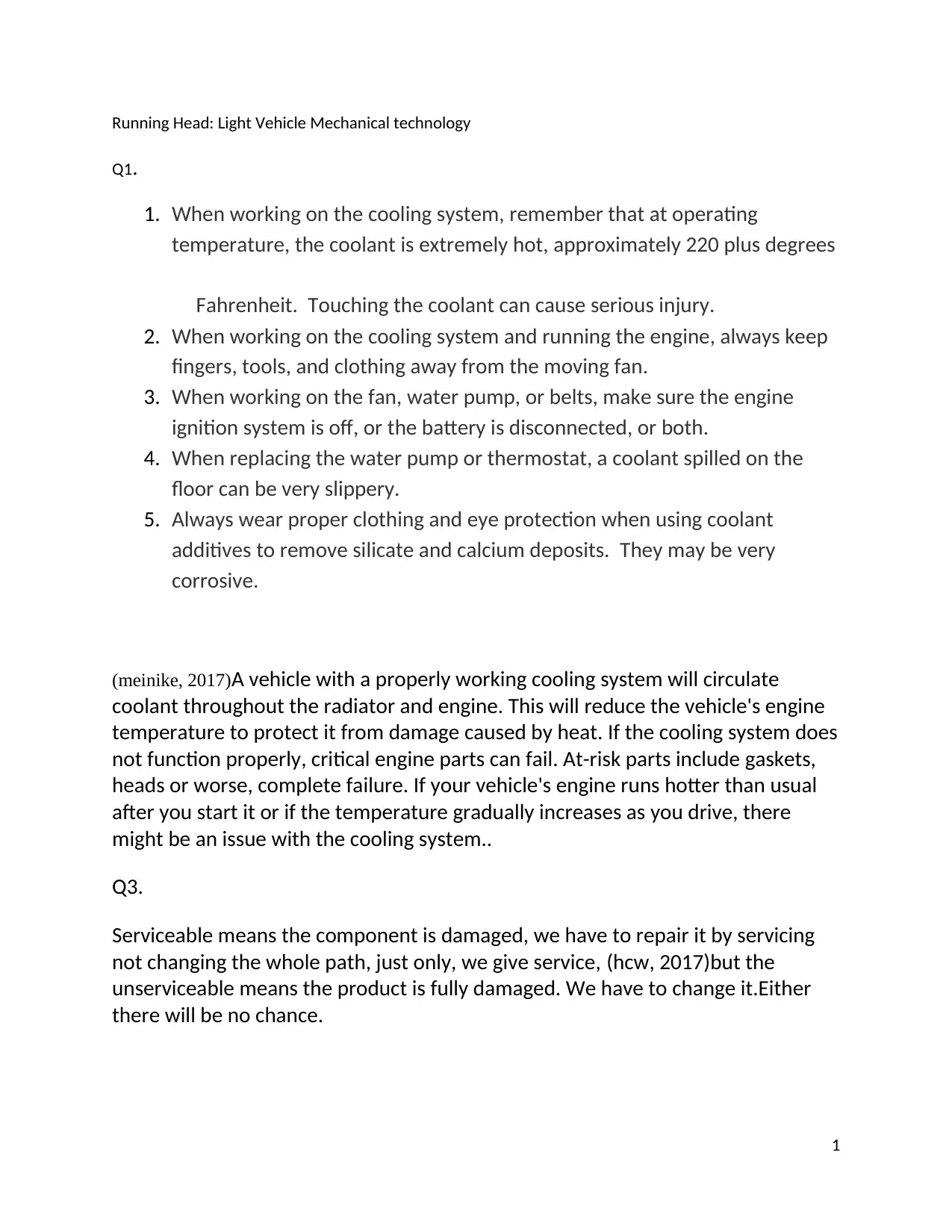
Running Head: Light Vehicle Mechanical technology
Q1.
1. When working on the cooling system, remember that at operating
temperature, the coolant is extremely hot, approximately 220 plus degrees
Fahrenheit. Touching the coolant can cause serious injury.
2. When working on the cooling system and running the engine, always keep
fingers, tools, and clothing away from the moving fan.
3. When working on the fan, water pump, or belts, make sure the engine
ignition system is off, or the battery is disconnected, or both.
4. When replacing the water pump or thermostat, a coolant spilled on the
floor can be very slippery.
5. Always wear proper clothing and eye protection when using coolant
additives to remove silicate and calcium deposits. They may be very
corrosive.
(meinike, 2017)A vehicle with a properly working cooling system will circulate
coolant throughout the radiator and engine. This will reduce the vehicle's engine
temperature to protect it from damage caused by heat. If the cooling system does
not function properly, critical engine parts can fail. At-risk parts include gaskets,
heads or worse, complete failure. If your vehicle's engine runs hotter than usual
after you start it or if the temperature gradually increases as you drive, there
might be an issue with the cooling system..
Q3.
Serviceable means the component is damaged, we have to repair it by servicing
not changing the whole path, just only, we give service, (hcw, 2017)but the
unserviceable means the product is fully damaged. We have to change it.Either
there will be no chance.
1
Q1.
1. When working on the cooling system, remember that at operating
temperature, the coolant is extremely hot, approximately 220 plus degrees
Fahrenheit. Touching the coolant can cause serious injury.
2. When working on the cooling system and running the engine, always keep
fingers, tools, and clothing away from the moving fan.
3. When working on the fan, water pump, or belts, make sure the engine
ignition system is off, or the battery is disconnected, or both.
4. When replacing the water pump or thermostat, a coolant spilled on the
floor can be very slippery.
5. Always wear proper clothing and eye protection when using coolant
additives to remove silicate and calcium deposits. They may be very
corrosive.
(meinike, 2017)A vehicle with a properly working cooling system will circulate
coolant throughout the radiator and engine. This will reduce the vehicle's engine
temperature to protect it from damage caused by heat. If the cooling system does
not function properly, critical engine parts can fail. At-risk parts include gaskets,
heads or worse, complete failure. If your vehicle's engine runs hotter than usual
after you start it or if the temperature gradually increases as you drive, there
might be an issue with the cooling system..
Q3.
Serviceable means the component is damaged, we have to repair it by servicing
not changing the whole path, just only, we give service, (hcw, 2017)but the
unserviceable means the product is fully damaged. We have to change it.Either
there will be no chance.
1
Paraphrase This Document
Need a fresh take? Get an instant paraphrase of this document with our AI Paraphraser
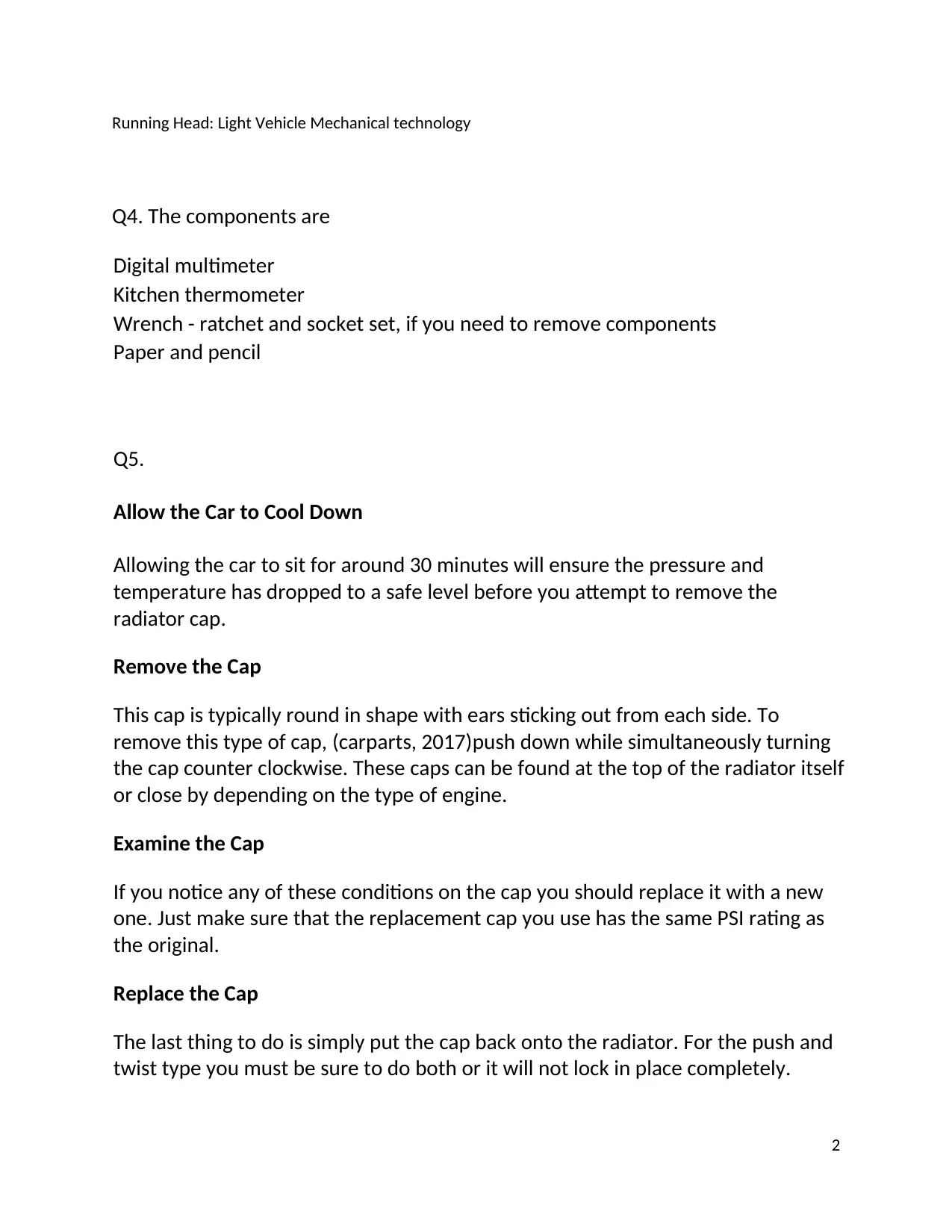
Running Head: Light Vehicle Mechanical technology
Q4. The components are
Digital multimeter
Kitchen thermometer
Wrench - ratchet and socket set, if you need to remove components
Paper and pencil
Q5.
Allow the Car to Cool Down
Allowing the car to sit for around 30 minutes will ensure the pressure and
temperature has dropped to a safe level before you attempt to remove the
radiator cap.
Remove the Cap
This cap is typically round in shape with ears sticking out from each side. To
remove this type of cap, (carparts, 2017)push down while simultaneously turning
the cap counter clockwise. These caps can be found at the top of the radiator itself
or close by depending on the type of engine.
Examine the Cap
If you notice any of these conditions on the cap you should replace it with a new
one. Just make sure that the replacement cap you use has the same PSI rating as
the original.
Replace the Cap
The last thing to do is simply put the cap back onto the radiator. For the push and
twist type you must be sure to do both or it will not lock in place completely.
2
Q4. The components are
Digital multimeter
Kitchen thermometer
Wrench - ratchet and socket set, if you need to remove components
Paper and pencil
Q5.
Allow the Car to Cool Down
Allowing the car to sit for around 30 minutes will ensure the pressure and
temperature has dropped to a safe level before you attempt to remove the
radiator cap.
Remove the Cap
This cap is typically round in shape with ears sticking out from each side. To
remove this type of cap, (carparts, 2017)push down while simultaneously turning
the cap counter clockwise. These caps can be found at the top of the radiator itself
or close by depending on the type of engine.
Examine the Cap
If you notice any of these conditions on the cap you should replace it with a new
one. Just make sure that the replacement cap you use has the same PSI rating as
the original.
Replace the Cap
The last thing to do is simply put the cap back onto the radiator. For the push and
twist type you must be sure to do both or it will not lock in place completely.
2
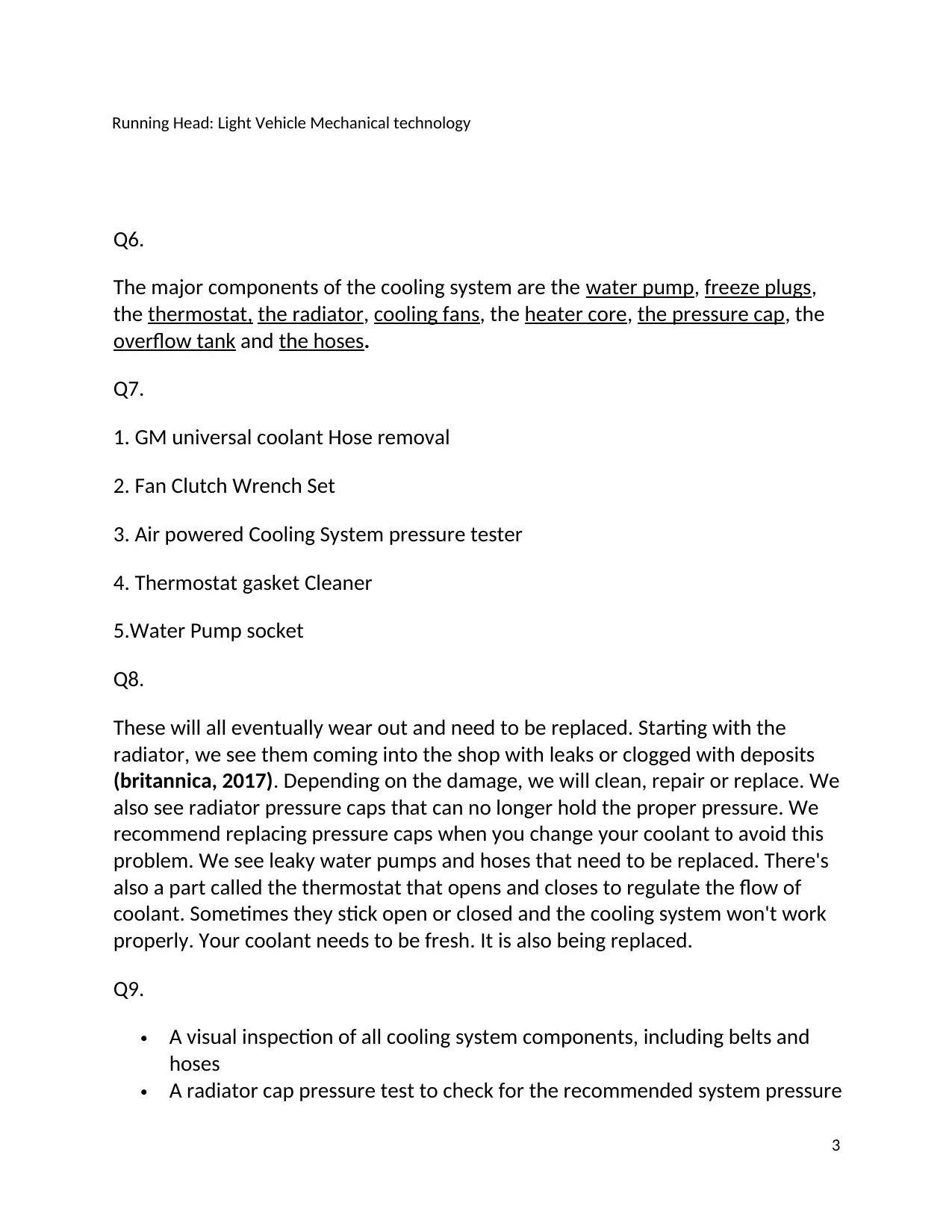
Running Head: Light Vehicle Mechanical technology
Q6.
The major components of the cooling system are the water pump, freeze plugs,
the thermostat, the radiator, cooling fans, the heater core, the pressure cap, the
overflow tank and the hoses.
Q7.
1. GM universal coolant Hose removal
2. Fan Clutch Wrench Set
3. Air powered Cooling System pressure tester
4. Thermostat gasket Cleaner
5.Water Pump socket
Q8.
These will all eventually wear out and need to be replaced. Starting with the
radiator, we see them coming into the shop with leaks or clogged with deposits
(britannica, 2017). Depending on the damage, we will clean, repair or replace. We
also see radiator pressure caps that can no longer hold the proper pressure. We
recommend replacing pressure caps when you change your coolant to avoid this
problem. We see leaky water pumps and hoses that need to be replaced. There's
also a part called the thermostat that opens and closes to regulate the flow of
coolant. Sometimes they stick open or closed and the cooling system won't work
properly. Your coolant needs to be fresh. It is also being replaced.
Q9.
A visual inspection of all cooling system components, including belts and
hoses
A radiator cap pressure test to check for the recommended system pressure
3
Q6.
The major components of the cooling system are the water pump, freeze plugs,
the thermostat, the radiator, cooling fans, the heater core, the pressure cap, the
overflow tank and the hoses.
Q7.
1. GM universal coolant Hose removal
2. Fan Clutch Wrench Set
3. Air powered Cooling System pressure tester
4. Thermostat gasket Cleaner
5.Water Pump socket
Q8.
These will all eventually wear out and need to be replaced. Starting with the
radiator, we see them coming into the shop with leaks or clogged with deposits
(britannica, 2017). Depending on the damage, we will clean, repair or replace. We
also see radiator pressure caps that can no longer hold the proper pressure. We
recommend replacing pressure caps when you change your coolant to avoid this
problem. We see leaky water pumps and hoses that need to be replaced. There's
also a part called the thermostat that opens and closes to regulate the flow of
coolant. Sometimes they stick open or closed and the cooling system won't work
properly. Your coolant needs to be fresh. It is also being replaced.
Q9.
A visual inspection of all cooling system components, including belts and
hoses
A radiator cap pressure test to check for the recommended system pressure
3
⊘ This is a preview!⊘
Do you want full access?
Subscribe today to unlock all pages.

Trusted by 1+ million students worldwide
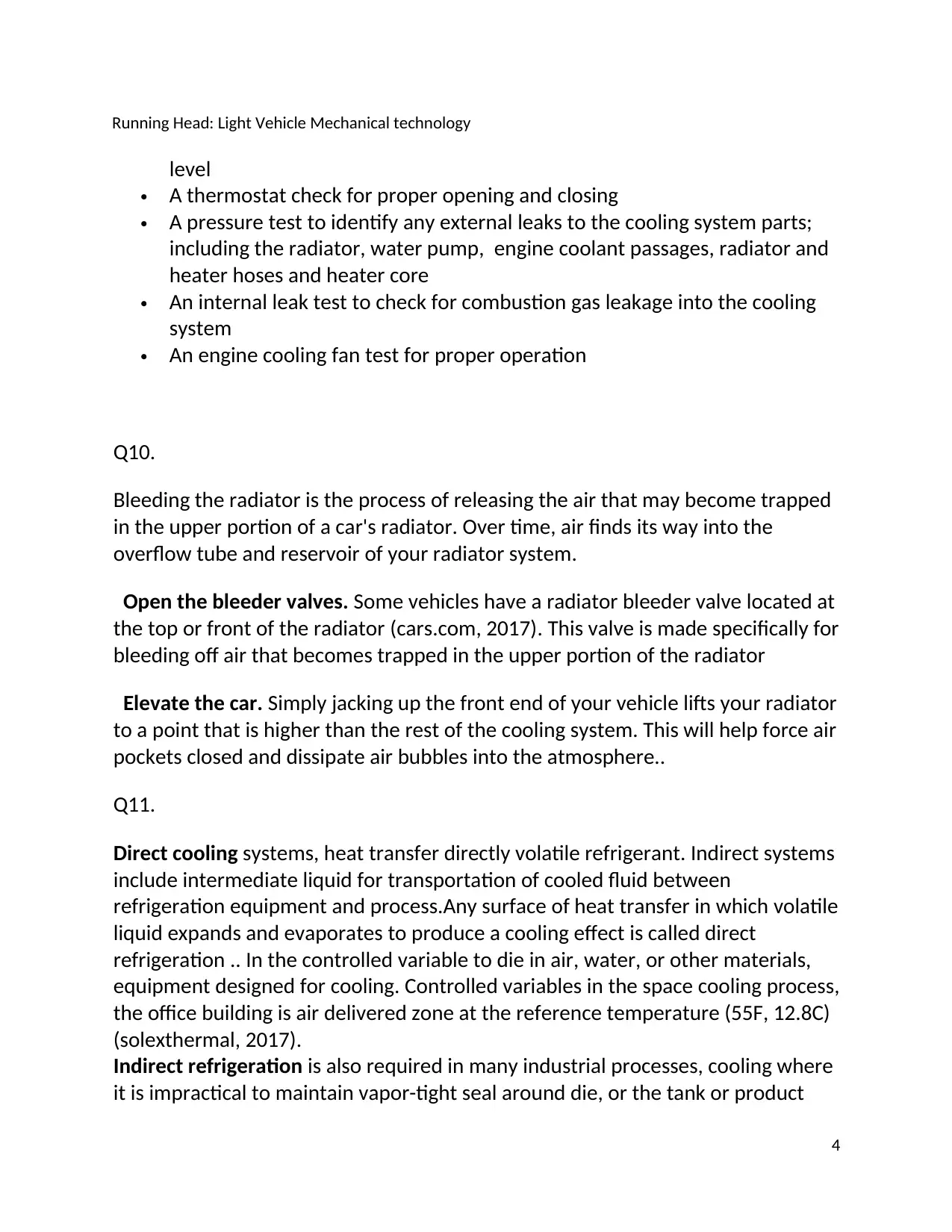
Running Head: Light Vehicle Mechanical technology
level
A thermostat check for proper opening and closing
A pressure test to identify any external leaks to the cooling system parts;
including the radiator, water pump, engine coolant passages, radiator and
heater hoses and heater core
An internal leak test to check for combustion gas leakage into the cooling
system
An engine cooling fan test for proper operation
Q10.
Bleeding the radiator is the process of releasing the air that may become trapped
in the upper portion of a car's radiator. Over time, air finds its way into the
overflow tube and reservoir of your radiator system.
Open the bleeder valves. Some vehicles have a radiator bleeder valve located at
the top or front of the radiator (cars.com, 2017). This valve is made specifically for
bleeding off air that becomes trapped in the upper portion of the radiator
Elevate the car. Simply jacking up the front end of your vehicle lifts your radiator
to a point that is higher than the rest of the cooling system. This will help force air
pockets closed and dissipate air bubbles into the atmosphere..
Q11.
Direct cooling systems, heat transfer directly volatile refrigerant. Indirect systems
include intermediate liquid for transportation of cooled fluid between
refrigeration equipment and process.Any surface of heat transfer in which volatile
liquid expands and evaporates to produce a cooling effect is called direct
refrigeration .. In the controlled variable to die in air, water, or other materials,
equipment designed for cooling. Controlled variables in the space cooling process,
the office building is air delivered zone at the reference temperature (55F, 12.8C)
(solexthermal, 2017).
Indirect refrigeration is also required in many industrial processes, cooling where
it is impractical to maintain vapor-tight seal around die, or the tank or product
4
level
A thermostat check for proper opening and closing
A pressure test to identify any external leaks to the cooling system parts;
including the radiator, water pump, engine coolant passages, radiator and
heater hoses and heater core
An internal leak test to check for combustion gas leakage into the cooling
system
An engine cooling fan test for proper operation
Q10.
Bleeding the radiator is the process of releasing the air that may become trapped
in the upper portion of a car's radiator. Over time, air finds its way into the
overflow tube and reservoir of your radiator system.
Open the bleeder valves. Some vehicles have a radiator bleeder valve located at
the top or front of the radiator (cars.com, 2017). This valve is made specifically for
bleeding off air that becomes trapped in the upper portion of the radiator
Elevate the car. Simply jacking up the front end of your vehicle lifts your radiator
to a point that is higher than the rest of the cooling system. This will help force air
pockets closed and dissipate air bubbles into the atmosphere..
Q11.
Direct cooling systems, heat transfer directly volatile refrigerant. Indirect systems
include intermediate liquid for transportation of cooled fluid between
refrigeration equipment and process.Any surface of heat transfer in which volatile
liquid expands and evaporates to produce a cooling effect is called direct
refrigeration .. In the controlled variable to die in air, water, or other materials,
equipment designed for cooling. Controlled variables in the space cooling process,
the office building is air delivered zone at the reference temperature (55F, 12.8C)
(solexthermal, 2017).
Indirect refrigeration is also required in many industrial processes, cooling where
it is impractical to maintain vapor-tight seal around die, or the tank or product
4
Paraphrase This Document
Need a fresh take? Get an instant paraphrase of this document with our AI Paraphraser
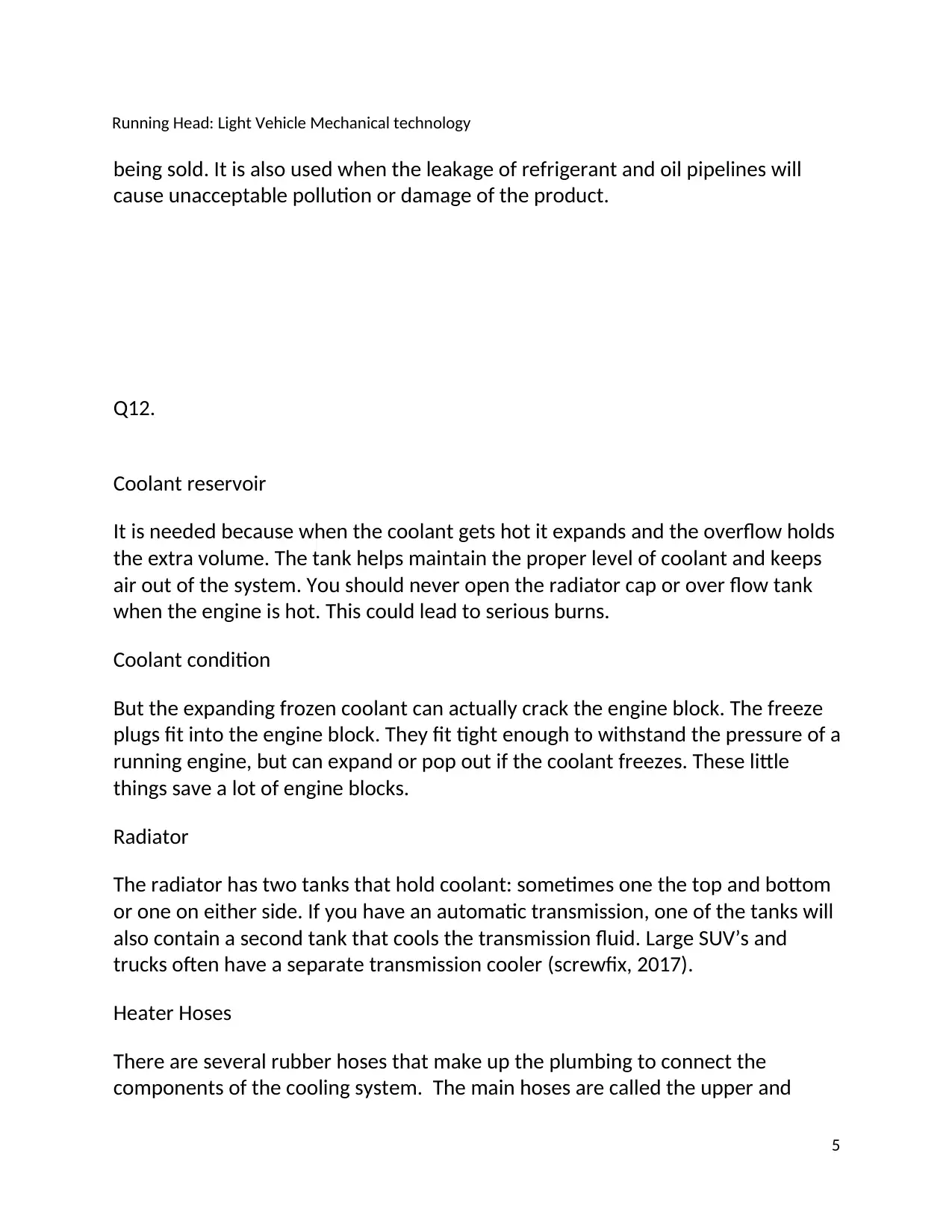
Running Head: Light Vehicle Mechanical technology
being sold. It is also used when the leakage of refrigerant and oil pipelines will
cause unacceptable pollution or damage of the product.
Q12.
Coolant reservoir
It is needed because when the coolant gets hot it expands and the overflow holds
the extra volume. The tank helps maintain the proper level of coolant and keeps
air out of the system. You should never open the radiator cap or over flow tank
when the engine is hot. This could lead to serious burns.
Coolant condition
But the expanding frozen coolant can actually crack the engine block. The freeze
plugs fit into the engine block. They fit tight enough to withstand the pressure of a
running engine, but can expand or pop out if the coolant freezes. These little
things save a lot of engine blocks.
Radiator
The radiator has two tanks that hold coolant: sometimes one the top and bottom
or one on either side. If you have an automatic transmission, one of the tanks will
also contain a second tank that cools the transmission fluid. Large SUV’s and
trucks often have a separate transmission cooler (screwfix, 2017).
Heater Hoses
There are several rubber hoses that make up the plumbing to connect the
components of the cooling system. The main hoses are called the upper and
5
being sold. It is also used when the leakage of refrigerant and oil pipelines will
cause unacceptable pollution or damage of the product.
Q12.
Coolant reservoir
It is needed because when the coolant gets hot it expands and the overflow holds
the extra volume. The tank helps maintain the proper level of coolant and keeps
air out of the system. You should never open the radiator cap or over flow tank
when the engine is hot. This could lead to serious burns.
Coolant condition
But the expanding frozen coolant can actually crack the engine block. The freeze
plugs fit into the engine block. They fit tight enough to withstand the pressure of a
running engine, but can expand or pop out if the coolant freezes. These little
things save a lot of engine blocks.
Radiator
The radiator has two tanks that hold coolant: sometimes one the top and bottom
or one on either side. If you have an automatic transmission, one of the tanks will
also contain a second tank that cools the transmission fluid. Large SUV’s and
trucks often have a separate transmission cooler (screwfix, 2017).
Heater Hoses
There are several rubber hoses that make up the plumbing to connect the
components of the cooling system. The main hoses are called the upper and
5
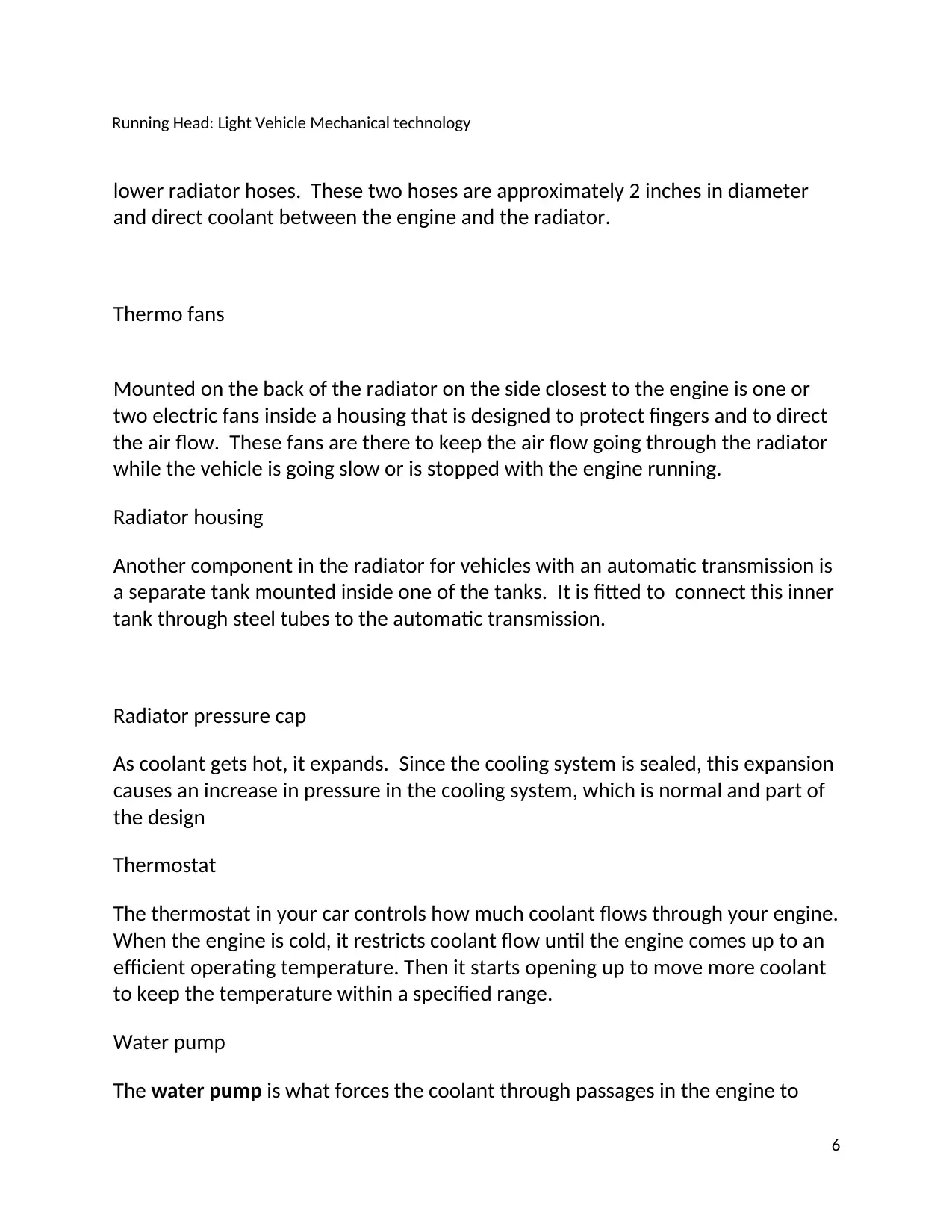
Running Head: Light Vehicle Mechanical technology
lower radiator hoses. These two hoses are approximately 2 inches in diameter
and direct coolant between the engine and the radiator.
Thermo fans
Mounted on the back of the radiator on the side closest to the engine is one or
two electric fans inside a housing that is designed to protect fingers and to direct
the air flow. These fans are there to keep the air flow going through the radiator
while the vehicle is going slow or is stopped with the engine running.
Radiator housing
Another component in the radiator for vehicles with an automatic transmission is
a separate tank mounted inside one of the tanks. It is fitted to connect this inner
tank through steel tubes to the automatic transmission.
Radiator pressure cap
As coolant gets hot, it expands. Since the cooling system is sealed, this expansion
causes an increase in pressure in the cooling system, which is normal and part of
the design
Thermostat
The thermostat in your car controls how much coolant flows through your engine.
When the engine is cold, it restricts coolant flow until the engine comes up to an
efficient operating temperature. Then it starts opening up to move more coolant
to keep the temperature within a specified range.
Water pump
The water pump is what forces the coolant through passages in the engine to
6
lower radiator hoses. These two hoses are approximately 2 inches in diameter
and direct coolant between the engine and the radiator.
Thermo fans
Mounted on the back of the radiator on the side closest to the engine is one or
two electric fans inside a housing that is designed to protect fingers and to direct
the air flow. These fans are there to keep the air flow going through the radiator
while the vehicle is going slow or is stopped with the engine running.
Radiator housing
Another component in the radiator for vehicles with an automatic transmission is
a separate tank mounted inside one of the tanks. It is fitted to connect this inner
tank through steel tubes to the automatic transmission.
Radiator pressure cap
As coolant gets hot, it expands. Since the cooling system is sealed, this expansion
causes an increase in pressure in the cooling system, which is normal and part of
the design
Thermostat
The thermostat in your car controls how much coolant flows through your engine.
When the engine is cold, it restricts coolant flow until the engine comes up to an
efficient operating temperature. Then it starts opening up to move more coolant
to keep the temperature within a specified range.
Water pump
The water pump is what forces the coolant through passages in the engine to
6
⊘ This is a preview!⊘
Do you want full access?
Subscribe today to unlock all pages.

Trusted by 1+ million students worldwide
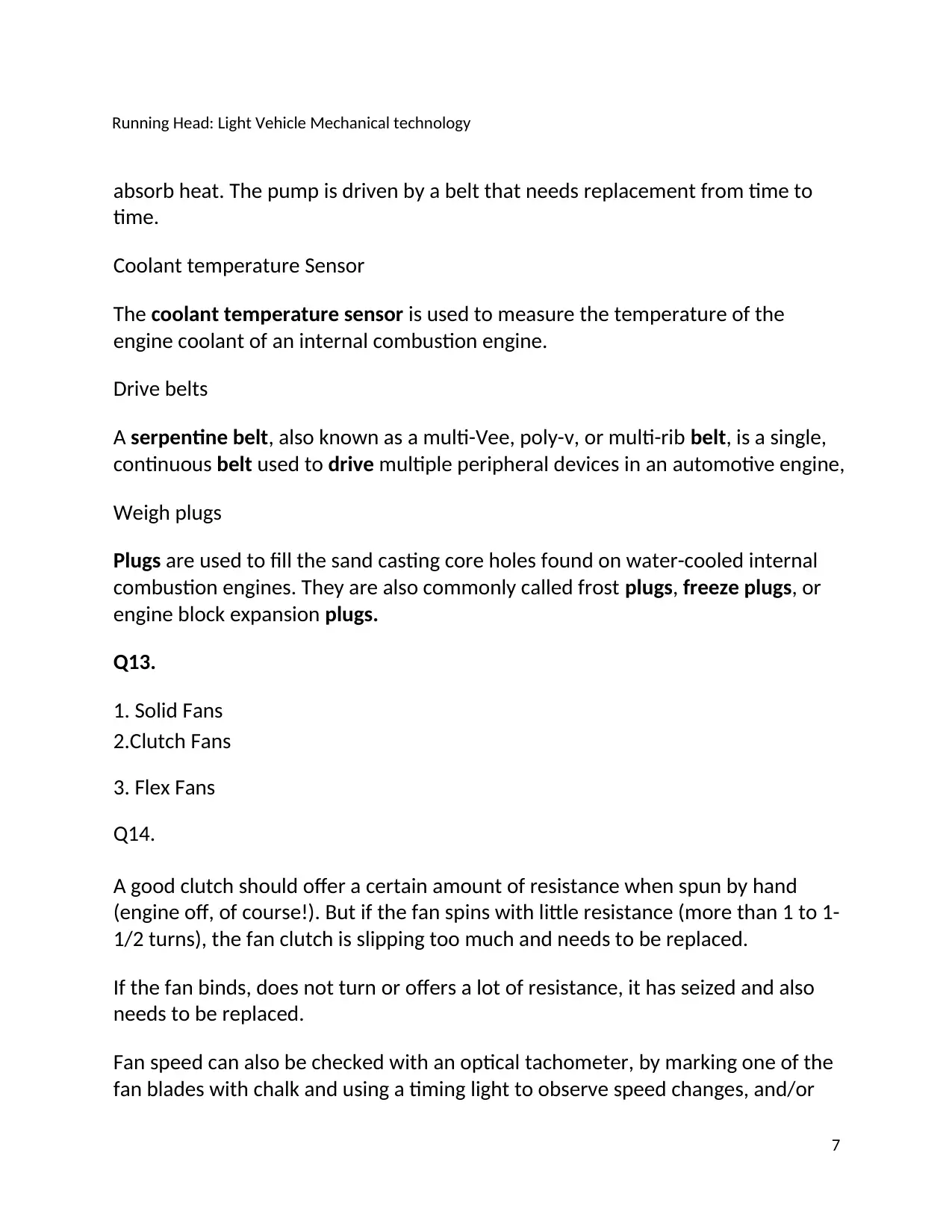
Running Head: Light Vehicle Mechanical technology
absorb heat. The pump is driven by a belt that needs replacement from time to
time.
Coolant temperature Sensor
The coolant temperature sensor is used to measure the temperature of the
engine coolant of an internal combustion engine.
Drive belts
A serpentine belt, also known as a multi-Vee, poly-v, or multi-rib belt, is a single,
continuous belt used to drive multiple peripheral devices in an automotive engine,
Weigh plugs
Plugs are used to fill the sand casting core holes found on water-cooled internal
combustion engines. They are also commonly called frost plugs, freeze plugs, or
engine block expansion plugs.
Q13.
1. Solid Fans
2.Clutch Fans
3. Flex Fans
Q14.
A good clutch should offer a certain amount of resistance when spun by hand
(engine off, of course!). But if the fan spins with little resistance (more than 1 to 1-
1/2 turns), the fan clutch is slipping too much and needs to be replaced.
If the fan binds, does not turn or offers a lot of resistance, it has seized and also
needs to be replaced.
Fan speed can also be checked with an optical tachometer, by marking one of the
fan blades with chalk and using a timing light to observe speed changes, and/or
7
absorb heat. The pump is driven by a belt that needs replacement from time to
time.
Coolant temperature Sensor
The coolant temperature sensor is used to measure the temperature of the
engine coolant of an internal combustion engine.
Drive belts
A serpentine belt, also known as a multi-Vee, poly-v, or multi-rib belt, is a single,
continuous belt used to drive multiple peripheral devices in an automotive engine,
Weigh plugs
Plugs are used to fill the sand casting core holes found on water-cooled internal
combustion engines. They are also commonly called frost plugs, freeze plugs, or
engine block expansion plugs.
Q13.
1. Solid Fans
2.Clutch Fans
3. Flex Fans
Q14.
A good clutch should offer a certain amount of resistance when spun by hand
(engine off, of course!). But if the fan spins with little resistance (more than 1 to 1-
1/2 turns), the fan clutch is slipping too much and needs to be replaced.
If the fan binds, does not turn or offers a lot of resistance, it has seized and also
needs to be replaced.
Fan speed can also be checked with an optical tachometer, by marking one of the
fan blades with chalk and using a timing light to observe speed changes, and/or
7
Paraphrase This Document
Need a fresh take? Get an instant paraphrase of this document with our AI Paraphraser
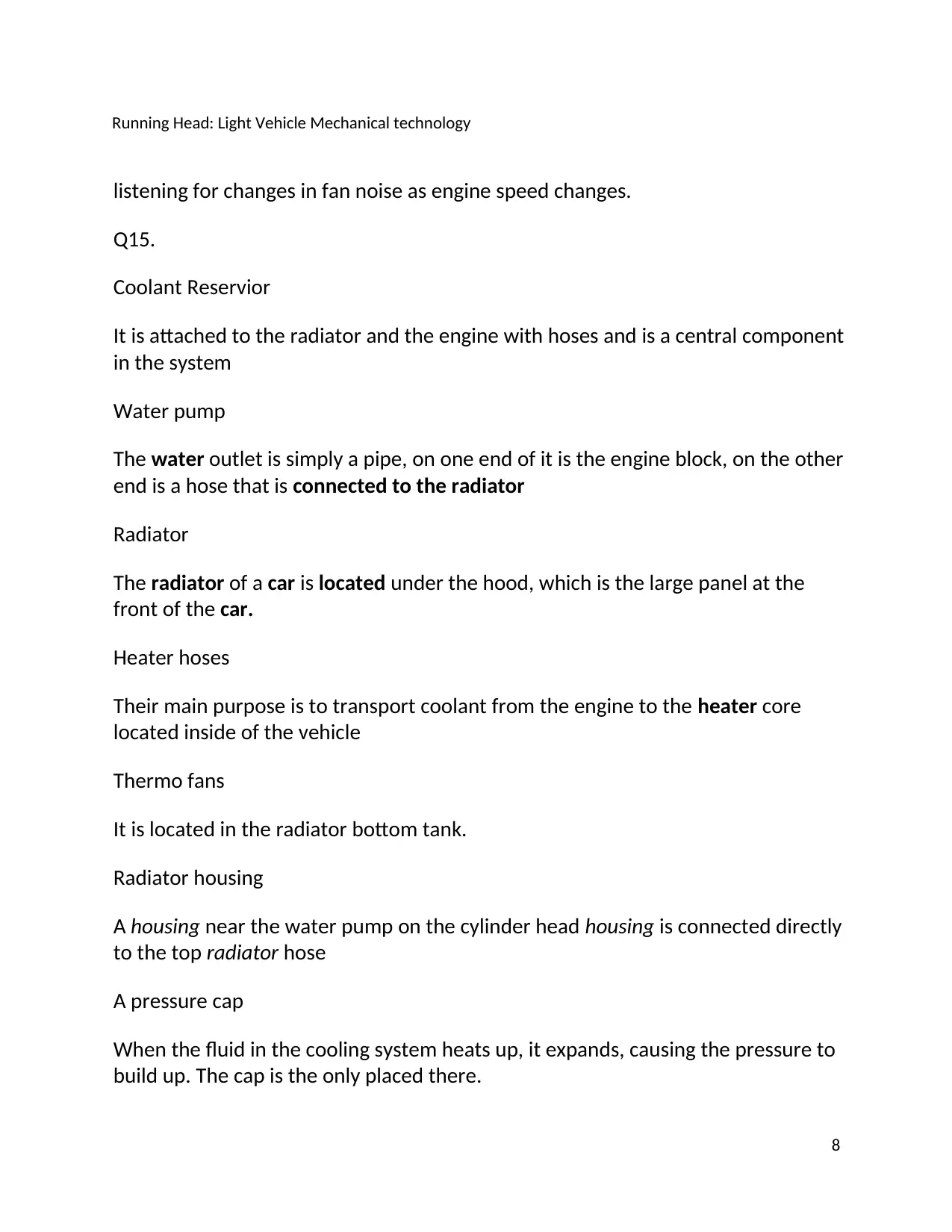
Running Head: Light Vehicle Mechanical technology
listening for changes in fan noise as engine speed changes.
Q15.
Coolant Reservior
It is attached to the radiator and the engine with hoses and is a central component
in the system
Water pump
The water outlet is simply a pipe, on one end of it is the engine block, on the other
end is a hose that is connected to the radiator
Radiator
The radiator of a car is located under the hood, which is the large panel at the
front of the car.
Heater hoses
Their main purpose is to transport coolant from the engine to the heater core
located inside of the vehicle
Thermo fans
It is located in the radiator bottom tank.
Radiator housing
A housing near the water pump on the cylinder head housing is connected directly
to the top radiator hose
A pressure cap
When the fluid in the cooling system heats up, it expands, causing the pressure to
build up. The cap is the only placed there.
8
listening for changes in fan noise as engine speed changes.
Q15.
Coolant Reservior
It is attached to the radiator and the engine with hoses and is a central component
in the system
Water pump
The water outlet is simply a pipe, on one end of it is the engine block, on the other
end is a hose that is connected to the radiator
Radiator
The radiator of a car is located under the hood, which is the large panel at the
front of the car.
Heater hoses
Their main purpose is to transport coolant from the engine to the heater core
located inside of the vehicle
Thermo fans
It is located in the radiator bottom tank.
Radiator housing
A housing near the water pump on the cylinder head housing is connected directly
to the top radiator hose
A pressure cap
When the fluid in the cooling system heats up, it expands, causing the pressure to
build up. The cap is the only placed there.
8
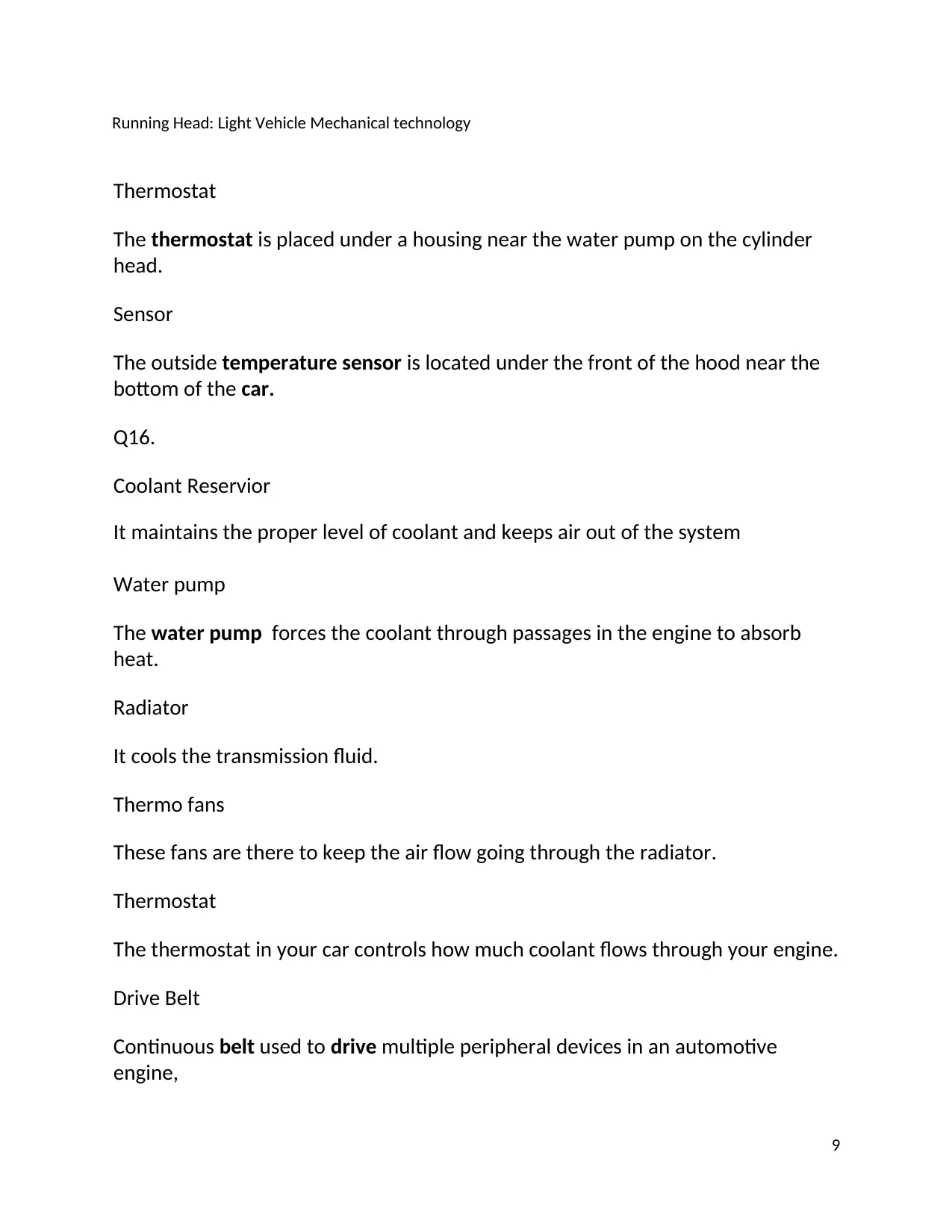
Running Head: Light Vehicle Mechanical technology
Thermostat
The thermostat is placed under a housing near the water pump on the cylinder
head.
Sensor
The outside temperature sensor is located under the front of the hood near the
bottom of the car.
Q16.
Coolant Reservior
It maintains the proper level of coolant and keeps air out of the system
Water pump
The water pump forces the coolant through passages in the engine to absorb
heat.
Radiator
It cools the transmission fluid.
Thermo fans
These fans are there to keep the air flow going through the radiator.
Thermostat
The thermostat in your car controls how much coolant flows through your engine.
Drive Belt
Continuous belt used to drive multiple peripheral devices in an automotive
engine,
9
Thermostat
The thermostat is placed under a housing near the water pump on the cylinder
head.
Sensor
The outside temperature sensor is located under the front of the hood near the
bottom of the car.
Q16.
Coolant Reservior
It maintains the proper level of coolant and keeps air out of the system
Water pump
The water pump forces the coolant through passages in the engine to absorb
heat.
Radiator
It cools the transmission fluid.
Thermo fans
These fans are there to keep the air flow going through the radiator.
Thermostat
The thermostat in your car controls how much coolant flows through your engine.
Drive Belt
Continuous belt used to drive multiple peripheral devices in an automotive
engine,
9
⊘ This is a preview!⊘
Do you want full access?
Subscribe today to unlock all pages.

Trusted by 1+ million students worldwide
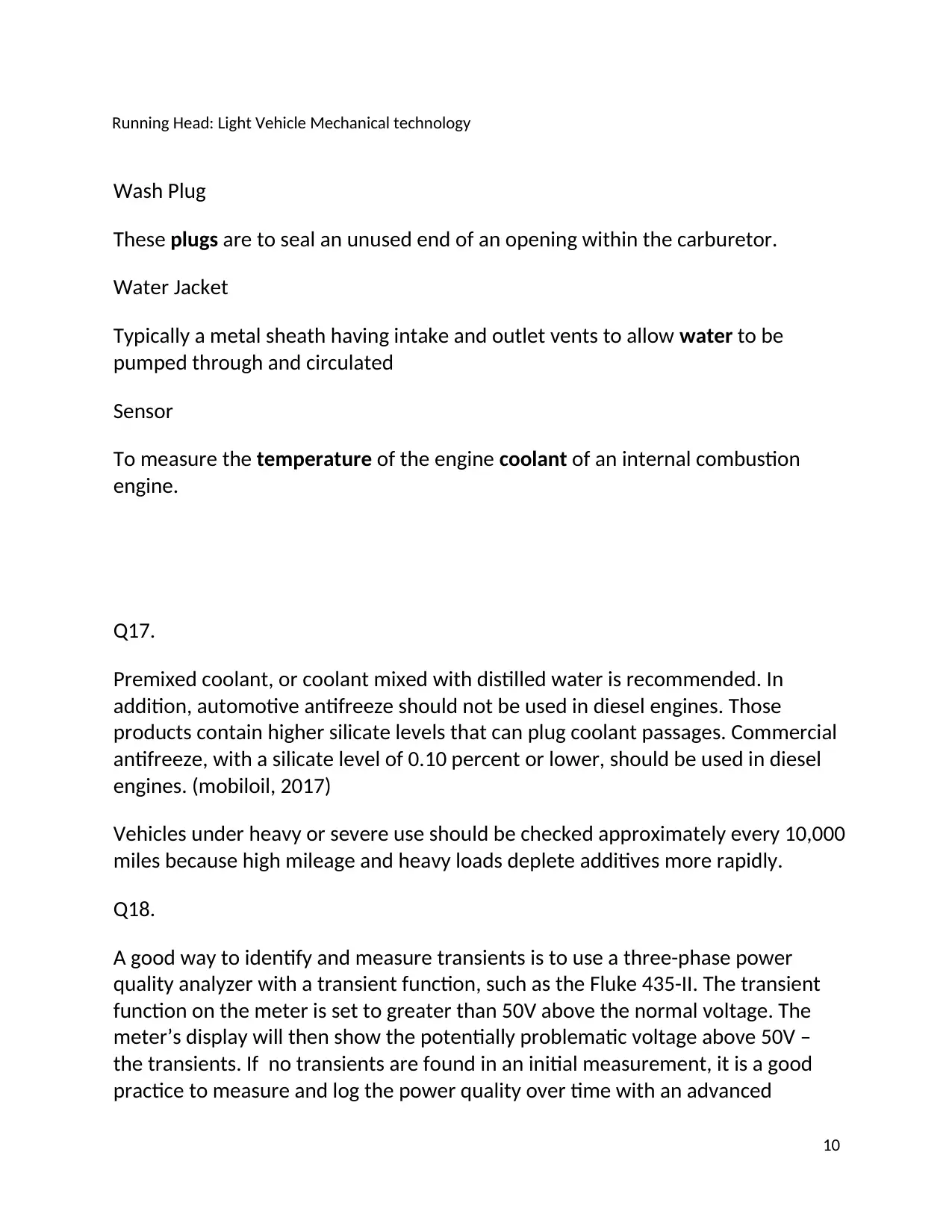
Running Head: Light Vehicle Mechanical technology
Wash Plug
These plugs are to seal an unused end of an opening within the carburetor.
Water Jacket
Typically a metal sheath having intake and outlet vents to allow water to be
pumped through and circulated
Sensor
To measure the temperature of the engine coolant of an internal combustion
engine.
Q17.
Premixed coolant, or coolant mixed with distilled water is recommended. In
addition, automotive antifreeze should not be used in diesel engines. Those
products contain higher silicate levels that can plug coolant passages. Commercial
antifreeze, with a silicate level of 0.10 percent or lower, should be used in diesel
engines. (mobiloil, 2017)
Vehicles under heavy or severe use should be checked approximately every 10,000
miles because high mileage and heavy loads deplete additives more rapidly.
Q18.
A good way to identify and measure transients is to use a three-phase power
quality analyzer with a transient function, such as the Fluke 435-II. The transient
function on the meter is set to greater than 50V above the normal voltage. The
meter’s display will then show the potentially problematic voltage above 50V –
the transients. If no transients are found in an initial measurement, it is a good
practice to measure and log the power quality over time with an advanced
10
Wash Plug
These plugs are to seal an unused end of an opening within the carburetor.
Water Jacket
Typically a metal sheath having intake and outlet vents to allow water to be
pumped through and circulated
Sensor
To measure the temperature of the engine coolant of an internal combustion
engine.
Q17.
Premixed coolant, or coolant mixed with distilled water is recommended. In
addition, automotive antifreeze should not be used in diesel engines. Those
products contain higher silicate levels that can plug coolant passages. Commercial
antifreeze, with a silicate level of 0.10 percent or lower, should be used in diesel
engines. (mobiloil, 2017)
Vehicles under heavy or severe use should be checked approximately every 10,000
miles because high mileage and heavy loads deplete additives more rapidly.
Q18.
A good way to identify and measure transients is to use a three-phase power
quality analyzer with a transient function, such as the Fluke 435-II. The transient
function on the meter is set to greater than 50V above the normal voltage. The
meter’s display will then show the potentially problematic voltage above 50V –
the transients. If no transients are found in an initial measurement, it is a good
practice to measure and log the power quality over time with an advanced
10
Paraphrase This Document
Need a fresh take? Get an instant paraphrase of this document with our AI Paraphraser
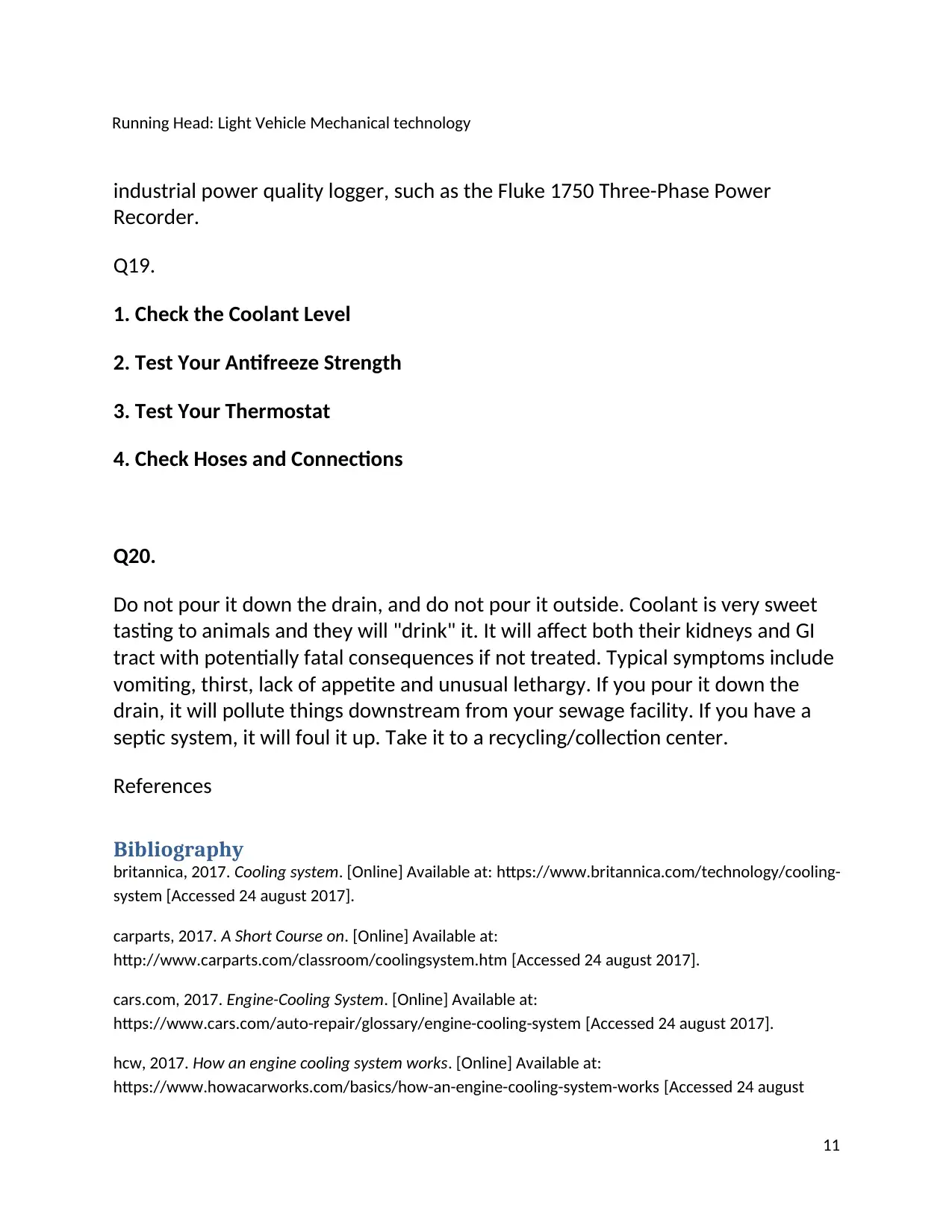
Running Head: Light Vehicle Mechanical technology
industrial power quality logger, such as the Fluke 1750 Three-Phase Power
Recorder.
Q19.
1. Check the Coolant Level
2. Test Your Antifreeze Strength
3. Test Your Thermostat
4. Check Hoses and Connections
Q20.
Do not pour it down the drain, and do not pour it outside. Coolant is very sweet
tasting to animals and they will "drink" it. It will affect both their kidneys and GI
tract with potentially fatal consequences if not treated. Typical symptoms include
vomiting, thirst, lack of appetite and unusual lethargy. If you pour it down the
drain, it will pollute things downstream from your sewage facility. If you have a
septic system, it will foul it up. Take it to a recycling/collection center.
References
Bibliography
britannica, 2017. Cooling system. [Online] Available at: https://www.britannica.com/technology/cooling-
system [Accessed 24 august 2017].
carparts, 2017. A Short Course on. [Online] Available at:
http://www.carparts.com/classroom/coolingsystem.htm [Accessed 24 august 2017].
cars.com, 2017. Engine-Cooling System. [Online] Available at:
https://www.cars.com/auto-repair/glossary/engine-cooling-system [Accessed 24 august 2017].
hcw, 2017. How an engine cooling system works. [Online] Available at:
https://www.howacarworks.com/basics/how-an-engine-cooling-system-works [Accessed 24 august
11
industrial power quality logger, such as the Fluke 1750 Three-Phase Power
Recorder.
Q19.
1. Check the Coolant Level
2. Test Your Antifreeze Strength
3. Test Your Thermostat
4. Check Hoses and Connections
Q20.
Do not pour it down the drain, and do not pour it outside. Coolant is very sweet
tasting to animals and they will "drink" it. It will affect both their kidneys and GI
tract with potentially fatal consequences if not treated. Typical symptoms include
vomiting, thirst, lack of appetite and unusual lethargy. If you pour it down the
drain, it will pollute things downstream from your sewage facility. If you have a
septic system, it will foul it up. Take it to a recycling/collection center.
References
Bibliography
britannica, 2017. Cooling system. [Online] Available at: https://www.britannica.com/technology/cooling-
system [Accessed 24 august 2017].
carparts, 2017. A Short Course on. [Online] Available at:
http://www.carparts.com/classroom/coolingsystem.htm [Accessed 24 august 2017].
cars.com, 2017. Engine-Cooling System. [Online] Available at:
https://www.cars.com/auto-repair/glossary/engine-cooling-system [Accessed 24 august 2017].
hcw, 2017. How an engine cooling system works. [Online] Available at:
https://www.howacarworks.com/basics/how-an-engine-cooling-system-works [Accessed 24 august
11
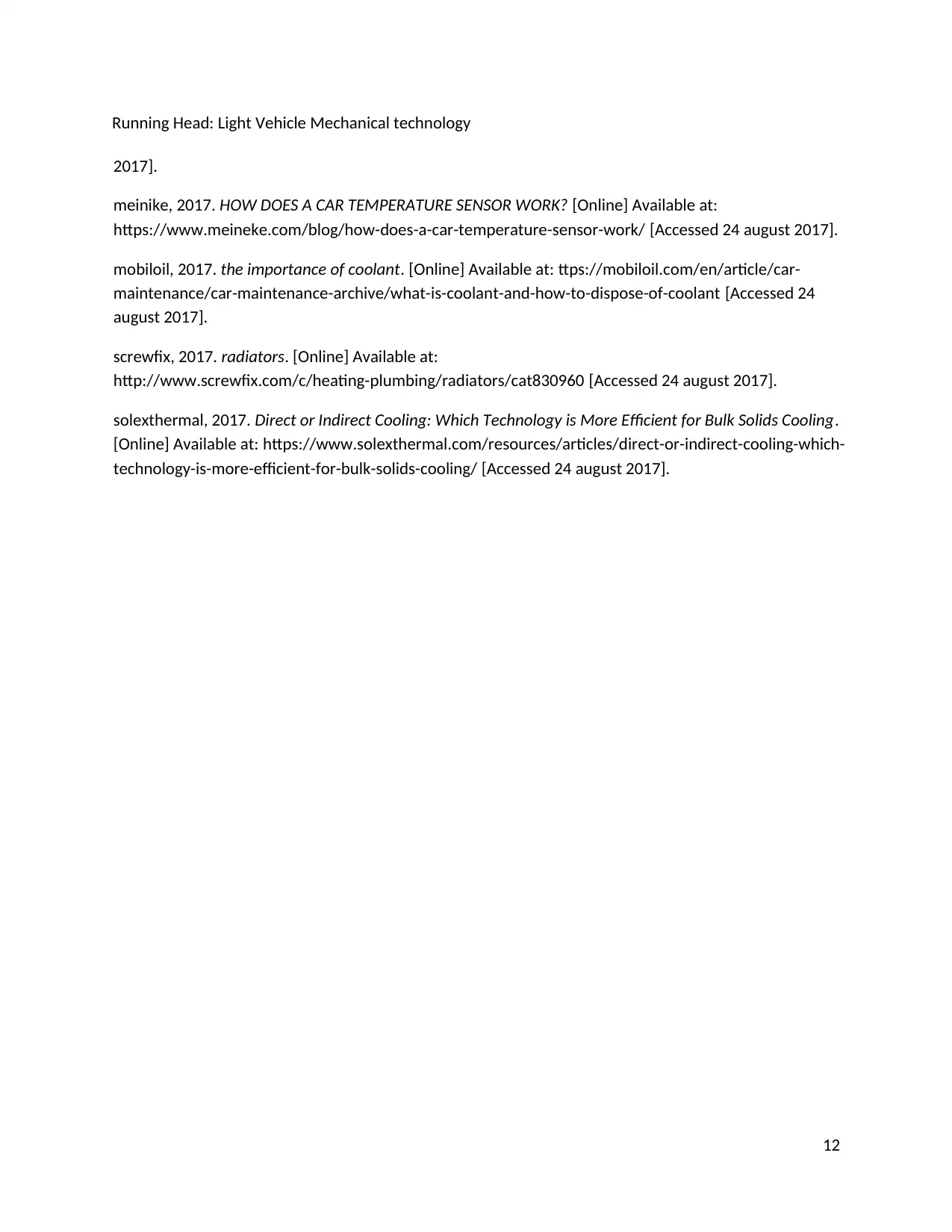
Running Head: Light Vehicle Mechanical technology
2017].
meinike, 2017. HOW DOES A CAR TEMPERATURE SENSOR WORK? [Online] Available at:
https://www.meineke.com/blog/how-does-a-car-temperature-sensor-work/ [Accessed 24 august 2017].
mobiloil, 2017. the importance of coolant. [Online] Available at: ttps://mobiloil.com/en/article/car-
maintenance/car-maintenance-archive/what-is-coolant-and-how-to-dispose-of-coolant [Accessed 24
august 2017].
screwfix, 2017. radiators. [Online] Available at:
http://www.screwfix.com/c/heating-plumbing/radiators/cat830960 [Accessed 24 august 2017].
solexthermal, 2017. Direct or Indirect Cooling: Which Technology is More Efficient for Bulk Solids Cooling.
[Online] Available at: https://www.solexthermal.com/resources/articles/direct-or-indirect-cooling-which-
technology-is-more-efficient-for-bulk-solids-cooling/ [Accessed 24 august 2017].
12
2017].
meinike, 2017. HOW DOES A CAR TEMPERATURE SENSOR WORK? [Online] Available at:
https://www.meineke.com/blog/how-does-a-car-temperature-sensor-work/ [Accessed 24 august 2017].
mobiloil, 2017. the importance of coolant. [Online] Available at: ttps://mobiloil.com/en/article/car-
maintenance/car-maintenance-archive/what-is-coolant-and-how-to-dispose-of-coolant [Accessed 24
august 2017].
screwfix, 2017. radiators. [Online] Available at:
http://www.screwfix.com/c/heating-plumbing/radiators/cat830960 [Accessed 24 august 2017].
solexthermal, 2017. Direct or Indirect Cooling: Which Technology is More Efficient for Bulk Solids Cooling.
[Online] Available at: https://www.solexthermal.com/resources/articles/direct-or-indirect-cooling-which-
technology-is-more-efficient-for-bulk-solids-cooling/ [Accessed 24 august 2017].
12
⊘ This is a preview!⊘
Do you want full access?
Subscribe today to unlock all pages.

Trusted by 1+ million students worldwide
1 out of 17
Your All-in-One AI-Powered Toolkit for Academic Success.
+13062052269
info@desklib.com
Available 24*7 on WhatsApp / Email
![[object Object]](/_next/static/media/star-bottom.7253800d.svg)
Unlock your academic potential
Copyright © 2020–2025 A2Z Services. All Rights Reserved. Developed and managed by ZUCOL.

